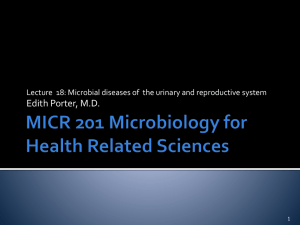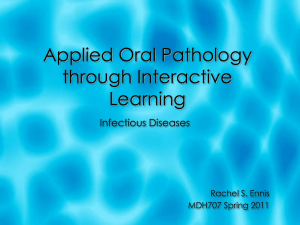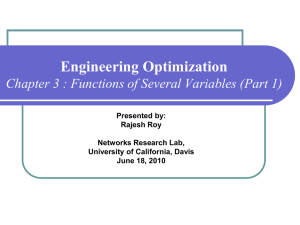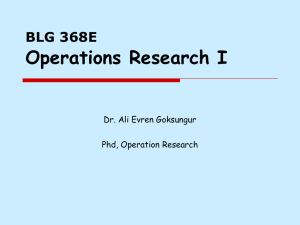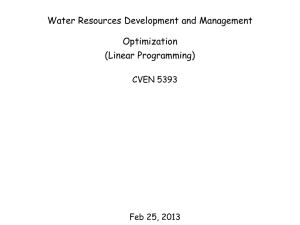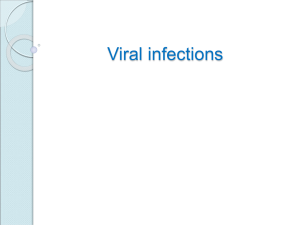3/2010 - Repatriation Medical Authority
advertisement
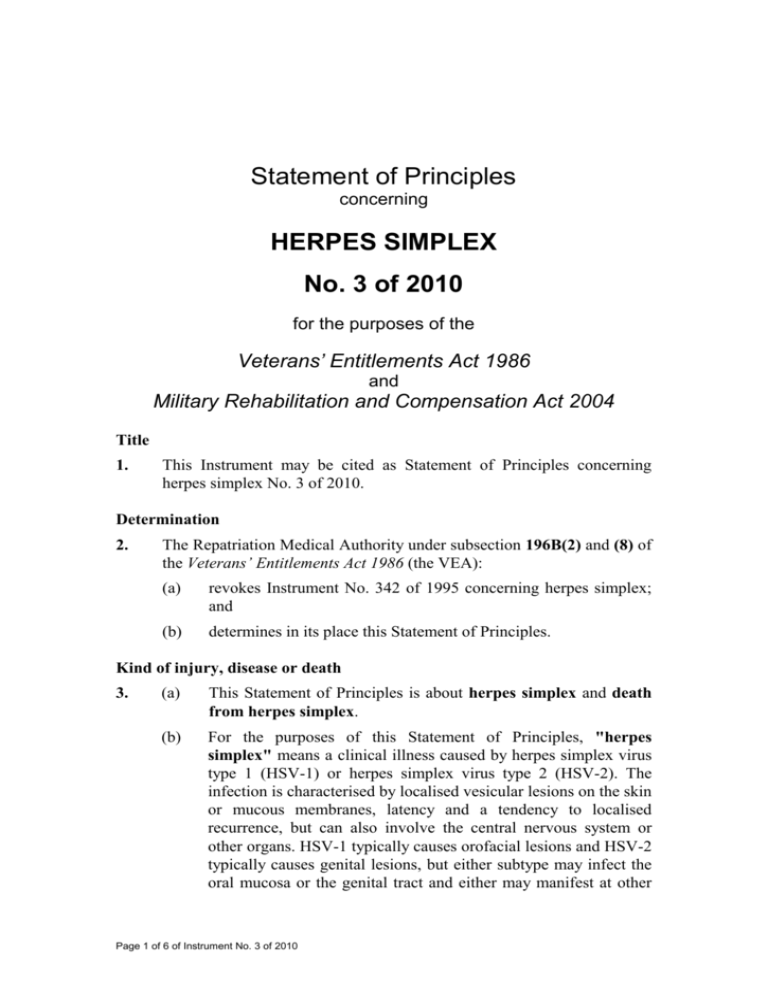
Statement of Principles concerning HERPES SIMPLEX No. 3 of 2010 for the purposes of the Veterans’ Entitlements Act 1986 and Military Rehabilitation and Compensation Act 2004 Title 1. This Instrument may be cited as Statement of Principles concerning herpes simplex No. 3 of 2010. Determination 2. The Repatriation Medical Authority under subsection 196B(2) and (8) of the Veterans’ Entitlements Act 1986 (the VEA): (a) revokes Instrument No. 342 of 1995 concerning herpes simplex; and (b) determines in its place this Statement of Principles. Kind of injury, disease or death 3. (a) This Statement of Principles is about herpes simplex and death from herpes simplex. (b) For the purposes of this Statement of Principles, "herpes simplex" means a clinical illness caused by herpes simplex virus type 1 (HSV-1) or herpes simplex virus type 2 (HSV-2). The infection is characterised by localised vesicular lesions on the skin or mucous membranes, latency and a tendency to localised recurrence, but can also involve the central nervous system or other organs. HSV-1 typically causes orofacial lesions and HSV-2 typically causes genital lesions, but either subtype may infect the oral mucosa or the genital tract and either may manifest at other Page 1 of 6 of Instrument No. 3 of 2010 sites. For the purposes of this Statement of Principles, lesions arising at a site where they have not previously occurred may be regarded as a new disease. (c) Herpes simplex attracts ICD-10-AM code B00 or A60. (d) In the application of this Statement of Principles, the definition of "herpes simplex" is that given at paragraph 3(b) above. Basis for determining the factors 4. The Repatriation Medical Authority is of the view that there is sound medical-scientific evidence that indicates that herpes simplex and death from herpes simplex can be related to relevant service rendered by veterans, members of Peacekeeping Forces, or members of the Forces under the VEA, or members under the Military Rehabilitation and Compensation Act 2004 (the MRCA). Factors that must be related to service 5. Subject to clause 7, at least one of the factors set out in clause 6 must be related to the relevant service rendered by the person. Factors 6. The factor that must as a minimum exist before it can be said that a reasonable hypothesis has been raised connecting herpes simplex or death from herpes simplex with the circumstances of a person’s relevant service is: (a) being exposed to HSV-1 or HSV-2 within the one month before the clinical onset of herpes simplex; or (b) having a significant thermal burn within the one month before the clinical onset of herpes simplex; or (c) being in an immunosuppressed state at the time of the clinical onset of herpes simplex; or (d) having surgery to nerve root ganglia within the two weeks before the clinical onset of herpes simplex, where the cutaneous distribution of herpes simplex corresponds with the nerve roots which were manipulated during surgery; or (e) for acute herpes simplex encephalitis and acute herpes simplex retinal necrosis only, having surgery to the brain within the two weeks before the clinical onset of herpes simplex; or Page 2 of 6 of Instrument No. 3 of 2010 (f) for orofacial herpes only, (i) (ii) having surgery to the face within the two weeks before the clinical onset of herpes simplex; or having an upper respiratory tract infection within the seven days before the clinical onset of herpes simplex; or (g) being exposed to sunlight or ultraviolet light at a level sufficient to induce at least mild erythema, within the seven days before the clinical onset of herpes simplex; or (h) being pregnant at the time of the clinical onset of herpes simplex; or (i) having a significant thermal burn within the one month before the clinical worsening of herpes simplex; or (j) being in an immunosuppressed state at the time of the clinical worsening of herpes simplex; or (k) having surgery to nerve root ganglia within the two weeks before the clinical worsening of herpes simplex, where the cutaneous distribution of herpes simplex corresponds with the nerve roots which were manipulated during surgery; or (l) for acute herpes simplex encephalitis and acute herpes simplex retinal necrosis only, having surgery to the brain within the two weeks before the clinical worsening of herpes simplex; or (m) for orofacial herpes only, (i) (ii) having surgery to the face within the two weeks before the clinical worsening of herpes simplex; or having an upper respiratory tract infection within the seven days before the clinical worsening of herpes simplex; or (n) being exposed to sunlight or ultraviolet light, at a site within the cutaneous distribution of a previous occurrence of herpes simplex infection, and at a level sufficient to induce at least mild erythema, within the seven days before the clinical worsening of herpes simplex; or (o) being pregnant at the time of the clinical worsening of herpes simplex; or Page 3 of 6 of Instrument No. 3 of 2010 (p) inability to obtain appropriate clinical management for herpes simplex. Factors that apply only to material contribution or aggravation 7. Paragraphs 6(i) to 6(p) apply only to material contribution to, or aggravation of, herpes simplex where the person’s herpes simplex was suffered or contracted before or during (but not arising out of) the person’s relevant service. Inclusion of Statements of Principles 8. In this Statement of Principles if a relevant factor applies and that factor includes an injury or disease in respect of which there is a Statement of Principles then the factors in that last mentioned Statement of Principles apply in accordance with the terms of that Statement of Principles as in force from time to time. Other definitions 9. For the purposes of this Statement of Principles: "a significant thermal burn" means an injury caused by the application of heat to body tissue, including inhalational burn, which is of sufficient severity to warrant hospitalisation; "being exposed to HSV-1 or HSV-2" means: (a) (b) (c) (d) having skin contact with a person infected with HSV-1 or HSV-2; having direct exposure to saliva or respiratory droplets infected with HSV-1 or HSV-2; having sexual contact with a person infected with HSV-1 or HSV-2; or having percutaneous exposure to vesicular fluid infected with HSV-1 or HSV-2; "being in an immunosuppressed state" means being in a condition of lowered immune function due to one of the following circumstances or conditions: (a) (b) (c) (d) (e) having a malignant disease; undergoing chemotherapy for the treatment of a malignant or proliferative disease; undergoing treatment with corticosteroids, excluding topical or inhaled corticosteroids; undergoing treatment with a tumour necrosis factor-α antagonist; having immunosuppressive treatment in the context of undergoing solid organ, stem cell or bone marrow transplantation; Page 4 of 6 of Instrument No. 3 of 2010 (f) (g) being infected with the human immunodeficiency virus (HIV); or having a coronary artery bypass graft; "death from herpes simplex" in relation to a person includes death from a terminal event or condition that was contributed to by the person’s herpes simplex; "ICD-10-AM code" means a number assigned to a particular kind of injury or disease in The International Statistical Classification of Diseases and Related Health Problems, 10th Revision, Australian Modification (ICD-10-AM), Sixth Edition, effective date of 1 July 2008, copyrighted by the National Centre for Classification in Health, Sydney, NSW, and having ISBN 978 1 74210 016 6; "relevant service" means: (a) (b) (c) (d) (e) operational service under the VEA; peacekeeping service under the VEA; hazardous service under the VEA; warlike service under the MRCA; or non-warlike service under the MRCA; "surgery to the face" means surgery involving the face or the skin of the face, including chemical peels, dermabrasion and laser resurfacing; "terminal event" means the proximate or ultimate cause of death and includes: (a) (b) (c) (d) (e) pneumonia; respiratory failure; cardiac arrest; circulatory failure; or cessation of brain function. Application 10. This Instrument applies to all matters to which section 120A of the VEA or section 338 of the MRCA applies. Date of effect 11. This Instrument takes effect from 13 January 2010. Page 5 of 6 of Instrument No. 3 of 2010 Dated this 22nd December day of The Common Seal of the Repatriation Medical Authority was affixed to this instrument in the presence of: ) ) ) ) KEN DONALD CHAIRPERSON Page 6 of 6 of Instrument No. 3 of 2010 2009

